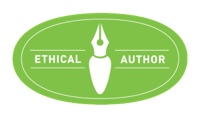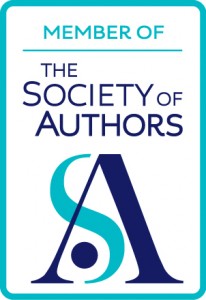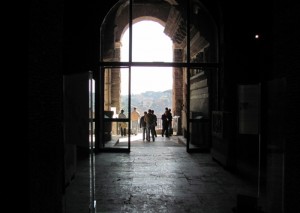 Basically, alternate history is a type of speculative fiction where stories are set in a world where historical events have unfolded differently from the way they did in the real world. The event that changed history (point of divergence or PoD) must be in the past from when the story is set and have affected the present in such a way that it can part-resemble our timeline or be very different. Sometimes there are actual historical characters, sometimes entirely fictional ones or a mixture of both. Basically, alternate history is a type of speculative fiction where stories are set in a world where historical events have unfolded differently from the way they did in the real world. The event that changed history (point of divergence or PoD) must be in the past from when the story is set and have affected the present in such a way that it can part-resemble our timeline or be very different. Sometimes there are actual historical characters, sometimes entirely fictional ones or a mixture of both.
 Although there’s a lot of it about and modern favourites of mine include Robert Harris’s Fatherland, Keith Roberts’ Pavane and C J Sansom’s Dominion, it’s nothing new. Roman historian Livy suggests that the Romans would have beaten Alexander the Great if he had lived longer and had turned west to attack the Romans (Book IX, sections 17-19 Ab urbe condita libri (The History of Rome), Titus Livius). Although there’s a lot of it about and modern favourites of mine include Robert Harris’s Fatherland, Keith Roberts’ Pavane and C J Sansom’s Dominion, it’s nothing new. Roman historian Livy suggests that the Romans would have beaten Alexander the Great if he had lived longer and had turned west to attack the Romans (Book IX, sections 17-19 Ab urbe condita libri (The History of Rome), Titus Livius).
But how plausible is alternate history?
I’m very grateful to TV Tropes for dissecting and qualifying the main types so clearly on the sliding scale of alternate history plausibility, and I’ll use their categories to explain in more detail.
 Like science fiction, alternate history varies in ‘hardness’ with readers and fans grading it by how plausible the alternation is measured against historical reality. At the ‘hard’ end are well-researched pieces that take into account historical sources and trends, logical changes due, for instance, to the butterfly effect, and try to relate events that flow logically from the point of divergence. At the ‘soft’ end are works of pure fantasy and ‘Rule of Cool’ (the level of ‘awesomeness’), generally a result of alien space bats (more classically, the dei ex machina). Like science fiction, alternate history varies in ‘hardness’ with readers and fans grading it by how plausible the alternation is measured against historical reality. At the ‘hard’ end are well-researched pieces that take into account historical sources and trends, logical changes due, for instance, to the butterfly effect, and try to relate events that flow logically from the point of divergence. At the ‘soft’ end are works of pure fantasy and ‘Rule of Cool’ (the level of ‘awesomeness’), generally a result of alien space bats (more classically, the dei ex machina).
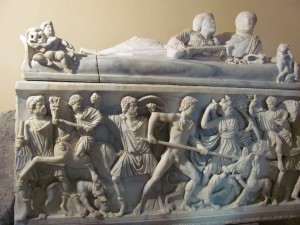 Sarcophagus frieze Type I – Hard Alternate History: These are works that stick to strict, sometimes scientific, standards in their plausibility. Research is often detailed and intensive. Most historical counter-factuals fall into this category.
Type II – Hard/Soft Alternate History: Often well researched with historical logic and methodology, but allows room for adventurous outcomes or Rule of Drama/Cool/Comedy (sound familiar?)
Type III – Soft Alternate History: Here, setting up a world that fits the writer’s creative objectives is more important than the plausibility of the setting’s alternate history. Research is often minimal to moderate and plausibility will take a back seat to Rule of Drama/Cool/Comedy.
Type IV – Utterly Implausible Alternate History: These are works that are so ‘soft’ that they melt and so implausible as to be effectively impossible. Often, the author puts their own ideology to the fore at the expense of research, historic details or sensible logistics. Readers with even a passing familiarity with history can’t take it seriously. The original term alien space bats was coined to refer to this level of implausibility.
 Type X – Fantastical Alternate History: In contrast with Type IV, these works are deliberately designed as pure fantasy, typically following the Rule of Cool. Mad ideas prevail such as Nazis on the moon in the 2012 film Iron Sky. Type X – Fantastical Alternate History: In contrast with Type IV, these works are deliberately designed as pure fantasy, typically following the Rule of Cool. Mad ideas prevail such as Nazis on the moon in the 2012 film Iron Sky.
Perception is, of course, subjective and depends upon the individual reader’s personal interpretations or on whether they are looking for serious historically logic development, a lighthearted, if not positively wacky, adventure story or something along the scale in-between. But no amount of plausibility, research or attention to ‘the rules’ or sense of fun will disguise poor writing, shallow characterisation and losing the plot.
Alison Morton is the author of Roma Nova thrillers, INCEPTIO, and PERFIDITAS. Third in series, SUCCESSIO, is out early summer 2014.
If you enjoyed this post, do share it with your friends!Like this:Like Loading...
 Today, I’m delighted to welcome Helen Hart, publishing director at SilverWood Books. She has written novels under pseudonyms for Scholastic, Virgin Books, OUP and HarperCollins. One of her Young Adult novels, written as Maya Snow, was shortlisted for the Solihull Children’s Book Award 2010. Today, I’m delighted to welcome Helen Hart, publishing director at SilverWood Books. She has written novels under pseudonyms for Scholastic, Virgin Books, OUP and HarperCollins. One of her Young Adult novels, written as Maya Snow, was shortlisted for the Solihull Children’s Book Award 2010.
Helen was on the judging panel for the 2010 and 2011 the Bristol Short Story Prize and has reviewed books for the Historical Novel Society (HNS) Indie Reviews.
I’m looking forward to hearing about her views on the ever-changing world of publishing!
Hi Helen. Welcome to the world of Roma Nova!
We’ve been working together for just over a year now since I decided to self-publish INCEPTIO and PERFIDITAS through SilverWood Books, but do satisfy my curiosity: why the name?
 That’s a nice question! I come from a small village in Dorset, which as far back as the Domesday Book was known by its old Celtic name of Litchet, meaning ‘the grey wood’. I like the name as it’s a piece of my heritage, and of course woods and trees are an important element of printed books (although nowadays wood pulp comes from sustainable and managed sources). Silver seemed a more appealing version of grey, so SilverWood Books was born. That’s a nice question! I come from a small village in Dorset, which as far back as the Domesday Book was known by its old Celtic name of Litchet, meaning ‘the grey wood’. I like the name as it’s a piece of my heritage, and of course woods and trees are an important element of printed books (although nowadays wood pulp comes from sustainable and managed sources). Silver seemed a more appealing version of grey, so SilverWood Books was born.
When talking to other people and indeed writing on this blog, I’ve referred to SilverWood Books as a “publishing services provider” Is this accurate?
I would say it is – at the moment. The publishing landscape is changing so fast, and new terminology is constantly being proposed for what we do, so we might also need to be flexible and change the way we refer to ourselves. It’s vital that the terms are widely recognized, so that writers can establish what we do and if we’re offering what they’re looking for. The Alliance of Independent Authors (ALLi) has recently referred to us as providing “author services”. I like that term because it brings the author to the centre of what we do rather than placing the publishing/publisher there, and that reflects our ethos of being what ALLi term “authorcentric”.
What marks SilverWood Books out in the publishing services market?
I’d like to think it’s friendliness and expertise of the SilverWood team, as well as the high quality of our books, in terms of design, layout and typesetting. One of our strengths is that our books aim to match the production values of traditional publishing houses such as Faber and Harper Collins. This means our authors can be confident about going out and marketing their book. Our authors also stand a good chance of persuading bookshops to stock their book, and of arranging author events and book signings.
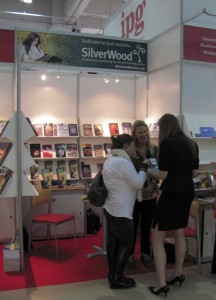 SilverWood Books at the London Book Fair 2013 What do authors report is the chief benefit of working with you from their point of view?
Most authors say it’s the close and supportive working relationship. Many seem to place great value regular contact, thoughtful advice, and having someone knowledgeable to run ideas past. With SilverWood, the support doesn’t end when the book is published but is on-going. Our preference is to work with a writer through their whole career rather than on a one-off book, and many authors return to work with us for a number of books.
How do you think the relationship a between self-publishing and the traditional publishing is evolving? For instance has self-publishing become a replacement slush pile or test-bed for traditional publishing?
I’m not sure how the test-bed is working. Some agents and publishers seem receptive, while others are a little more resistant. It’s a constantly evolving landscape, and attitudes are shifting all the time.
Sometimes all self-published authors are lumped together from the enthusiastic, but unskilled, DIY author at one end and the top of the range providers like SilverWood Books at the other. Do you think the self-publishing market is changing, polarizing into different quality layers?
That’s an interesting thought. Possibly, although it’s slow progress. The perception of “all self-published books are rubbish” has such a strong hold that it can be hard work for authors to overcome that prejudice. The good news is that there are new initiatives which are helping to raise awareness of books which have been published well, from IndieBRAG’s recommended self-published book “Medallion” scheme, to ALLi’s “Open Up to Indies” and the recent Guardian newspaper blog posts which acknowledge that self-published books can be good. Recently the Guardian online invited readers to recommend good self-published books, and received over 3,400 entries. Of the top two dozen that made it onto their published list, we were really pleased and proud to see not one but two SilverWood authors – travel writer Ed Hancox and historical novelist Helen Hollick.
And how do you see the self-publishing sector maturing in say the next 12 and 24 months?
“Maturing” is a good word. I feel confident that self-publishing will go from strength to strength and continue to become more and more acceptable. Things can only improve as recognition builds that the self-publishing sector is producing well-written, professionally-edited and expertly-designed books. I genuinely believe that readers don’t care who funded the book as long as it’s a good read, and they can get hold of it relatively easily.
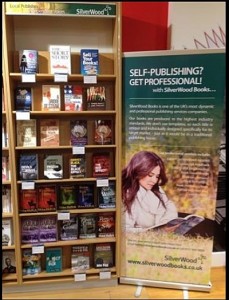 I’m looking forward to meeting up with Helen again at the SilverWood Books Writing and Self-Publishing Open Day at Foyles, Bristol on 25 January 2014. It’s fully booked, but there’s another scheduled for September 2014. I’m looking forward to meeting up with Helen again at the SilverWood Books Writing and Self-Publishing Open Day at Foyles, Bristol on 25 January 2014. It’s fully booked, but there’s another scheduled for September 2014.
Left: Display in Foyles, Bristol of SilverWood Books. INCEPTIO and PERFIDITAS are on the third shelf down!
Find out more about SilverWood Books here: www.silverwoodbooks.co.uk
Alison Morton is the author of Roma Nova thrillers, INCEPTIO, and PERFIDITAS. Third in series, SUCCESSIO, is out early summer 2014.
If you enjoyed this post, do share it with your friends!Like this:Like Loading...
 In the past year in the UK, there has been a lot of talk on the news about “plebs”. I’m not offering any comment on that, but listening to media reports and reading social media gossip, I started to wonder if people knew where the terms came from. Ah! It’s those pesky Romans again. So here’s a blaggers guide… In the past year in the UK, there has been a lot of talk on the news about “plebs”. I’m not offering any comment on that, but listening to media reports and reading social media gossip, I started to wonder if people knew where the terms came from. Ah! It’s those pesky Romans again. So here’s a blaggers guide…
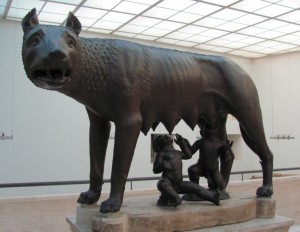 First, the caveat: “Rome” lasted 1229 years and the roles, power, responsibilities, ranks and privileges fluctuated over that long period which ran from the Regal era, Republic, Principate, Dominate and into Late Antiquity, so this guide is a general one. First, the caveat: “Rome” lasted 1229 years and the roles, power, responsibilities, ranks and privileges fluctuated over that long period which ran from the Regal era, Republic, Principate, Dominate and into Late Antiquity, so this guide is a general one.
Basically, there were two main classes of free citizens in ancient Rome –
the patricians (aristocrats) and the plebeians (everybody else). Equites, often called knights, formed a band of mid-level aristocrats ranking below the patricians.
Patricians: upper class, the nobility and wealthy land owners, often senators (law-makers), governors, senior magistrates, advisors to the emperor. Augustus introduced n a new rule that senators had to have property worth 1,000,000 sesterces. Senators were also not allowed to become directly involved in business – particularly shipping or government contracts where there might be a conflict of interest. Given they were also unpaid, this meant that only a small percentage of the population could afford to become deeply involved in politics.
 Vespasian Equites: middle-ranking, provided senior administrative and military officers and came to dominate mining, shipping, manufacturing industry and tax farming. Later, they included leading non-Italian families who rose to prominence, such as emperor Vespasian.
Plebeians: everyone else in ancient Rome from well-to-do tradesmen all the way down to the very poor. Shopkeepers, crafts people, merchants and skilled or unskilled workers might be plebeian. From the 4th century BC or earlier, some of the most prominent and wealthy Roman families, as identified by their gens name (nomen), were of plebeian status. Literary references to the plebs, however, usually mean the ordinary citizens of Rome as a collective, as distinguished from the elite. In the very earliest days of Rome, plebeians were any tribe without advisers to the king. In time, the word came to mean the common people. Plebeians were excluded from becoming magistrates or entering religious colleges, and they were not permitted to know the laws by which they were governed. Plebeians served in the army, but rarely became military leaders.
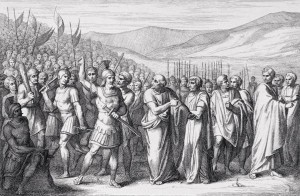 The Secession of the People to the Mons Sacer, engraved by B. Barloccini, 1849 Dissatisfaction with the status quo occasionally mounted to the point that the plebeians engaged in a sort of general strike, a secessio plebis, during which they would withdraw from Rome, refusing to fight and leave the patricians to face the enemy by themselves. From 494 to 287 BC, five such actions during this “Conflict of the Orders” resulted in the establishment of plebeian offices (the tribunes and plebeian aediles), the publication of the laws (Twelve Tables), the establishment of the right of plebeian-patrician intermarriage (Lex Canuleia), the opening of the highest offices of government and some state priesthoods to the plebeians, and legislation (Lex Hortensia) that made resolutions passed by the assembly of plebeians, the concilium plebis, binding on all citizens.
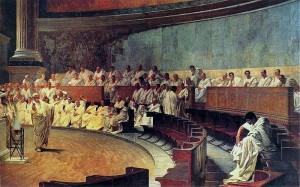 Cicero Denounces Catiline, fresco by Cesare Maccari, 1882–88 Social mobility
During the Second Samnite War (326–304 BC), plebeians who had risen to power through these social reforms began to acquire the aura of nobilitas, “nobility”, marking the creation of a ruling elite of nobiles that allied the interests of patricians and noble plebeians. From the mid-4th century to the early 3rd century BC, several plebeian-patrician “tickets” for the consulship suggests political cooperation between the classes. Although nobilitas was not a formal social rank during the Republican era, a plebeian who had attained the consulship was regarded as having brought nobility to his family. Such a man was a novus homo, a “new man” or self-made noble, and his sons and descendants were nobiles. Marius and Cicero are notable examples of novi homines in the late Republic, when many of Rome’s richest and most powerful men—such as Lucullus, Crassus, and Pompey—were plebeian nobles.
 Me and G.J.Caesar Some or perhaps many noble plebeians, including Cicero and Lucullus, aligned their political interests with the faction of optimates, conservatives who sought to preserve senatorial prerogatives. By contrast, the populares or “people’s party”, which sought to champion the plebs in the sense of “common people”, were sometimes led by patricians such as G.Julius Caesar and Clodius Pulcher.
Straightforward, isn’t it? But I hope I’ve shed some light on the origin of plebs and patricians.
Alison Morton is the author of Roma Nova thrillers – INCEPTIO, PERFIDITAS, SUCCESSIO, AURELIA, INSURRECTIO and RETALIO. CARINA, a novella, and ROMA NOVA EXTRA, a collection of short stories, are now available. Audiobooks are available for four of the series. NEXUS, an Aurelia Mitela novella, is now out.
Download ‘Welcome to Roma Nova’, a FREE eBook, as a thank you gift when you sign up to Alison’s monthly email newsletter. You’ll also be first to know about Roma Nova news and book progress before everybody else, and take part in giveaways.
If you enjoyed this post, do share it with your friends!Like this:Like Loading...
 Today, I’m delighted to welcome Geraldine Clouston, founder and president of IndieBRAG, an organisation whose mission is “to recognize quality on the part of authors who self-publish both print and digital books.” Today, I’m delighted to welcome Geraldine Clouston, founder and president of IndieBRAG, an organisation whose mission is “to recognize quality on the part of authors who self-publish both print and digital books.”
One fearsome, but in a way reassuring, statistic is that IndieBRAG rejects 90% of books that it considers. Not quite two years old, it already has an excellent reputation as a serious “Guardian at the Gate”. At the recent Self-Published Book Expo in New York, IndieBRAG presented an authoritative report on self-publishing and was the only panel out of 17 filmed by C-SPAN’s Book TV.
Welcome to Roma Nova, Geri.
Thank you so much for letting me tell you about my passion – indieBRAG!
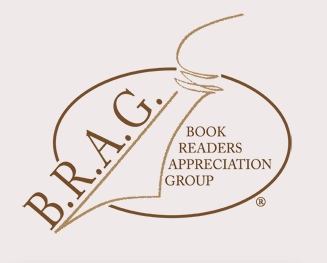 What is the background to you starting IndieBRAG? What is the background to you starting IndieBRAG?
Several years ago my husband and I attended the Self-Publishing Book Expo in New York City for the first time. We were, of course, not surprised to find many self-published authors at the Expo who were looking for help. However, we were surprised to discover that after these authors had published their books very few of them knew what to do next. We quickly realized that with the explosion of self-publishing, it is very hard for an indie author to get any attention for their book. And more to the point, given that much of what is self-published is not worth a reader’s time or money, it is a major challenge for a good self-published book to rise above the rest.
Tell us about your process for evaluating self-published work.
After a book is nominated through our website it is subjected to a rigorous selection process. This entails an initial screening to ensure that the author’s work meets certain minimum standards of quality and content. If it passes this preliminary assessment it is then read by members drawn from our reader group. We have over 150 readers in 11 countries who regularly read self-published books for us. They judge the merits of the book based on a comprehensive list of criteria, the most important of which is whether or not they would recommend it to their best friend. If a book meets our high standards, we award it our B.R.A.G. Medallion and present it on our website.
There are two important things to note about our process- First, we are not agents, literary experts, or publishers. We are simply ordinary people who are passionate about reading books; the same people who buy books. And second, we do not permit any contact between our readers and authors, or other readers. This gives the reader an opportunity to make a decision without any undue influence from anyone.
At the SPBE in New York, you gave a major presentation called “THE GOOD, THE BAD, AND THE UGLY” of self-published books. I understand this was based on surveys and interviews with your readers and BRAG Medallion authors. What were your main findings?
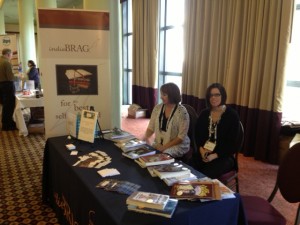 Yes, in September we conducted surveys among both our readers and Medallion authors, the key findings of which were presented at the Expo. The results covered a broad range of topics, but perhaps the most significant finding was that while good editing won’t make a book successful, bad editing will almost certainly kill it. The adage that you rarely get a second chance for a first impression holds especially true in self-publishing! Yes, in September we conducted surveys among both our readers and Medallion authors, the key findings of which were presented at the Expo. The results covered a broad range of topics, but perhaps the most significant finding was that while good editing won’t make a book successful, bad editing will almost certainly kill it. The adage that you rarely get a second chance for a first impression holds especially true in self-publishing!
We also found that over 70% of readers download a free sample of a book, or peruse it in a book store, before they buy it. Importantly, most will only read a few pages before they decide to buy it so it is critical to grab their attention right away. A significant finding from our authors was that over 80% use social media to promote their books, and most believe the degree to which this helps them is directly proportional to the effort they put into it.
More of our results can be found in my blog on our website.
(Read through all of Geri’s posts from the SPBE – well worth it!)
Should self-published books be priced at rock-bottom to encourage readers or would this give a false message?
Pricing has been a major topic of conversation lately in the self-publishing industry and we addressed this issue in our surveys. Again I would suggest that you check out our blog for more details. The most striking finding was that many authors are pricing their books too low. We learned that most readers are willing to pay at least $5.00 for an eBook and up to $15.00 for a trade paperback. Moreover, a price of $.99 often red flags a book as being self-published. Although this is becoming less of a negative, an author should want their book to be judged by the quality of the writing not how it was published, and such a low price may give the wrong impression. Also offering it a higher price gives an author greater flexibility in running reduced price promotions.
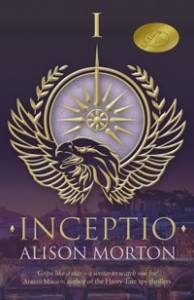 What is the chief benefit of B.R.A.G. MedallionTM books for the reader? What is the chief benefit of B.R.A.G. MedallionTM books for the reader?
The B.R.A.G.Medallion is quickly becoming recognized as a sign of quality in self-published books. It attests to the fact that a reader can be confident that a book bearing the B.R.A.G.Medallion will not be a waste of their time or money!
How do you think readers are going to find books in the future with more digital books and fewer physical bookshops? And with ever more books coming on the market each year?
I believe this speaks to how the B.R.A.G.Medallion best serves the reading audience. Instead of perusing the thousands of books online, a reader can go to our website, pick a genre and find a book other readers recommend highly. Or, when they are shopping elsewhere, such as at amazon.com or barnesandnoble.com, a reader who sees the B.R.A.G.Medallion will know that this is a book worthy of consideration.
And how will you be spreading the message about IndieBRAG in 2014?
We will continue to actively promote our B.R.A.G.Medallion books, as well as indieBRAG itself, on social media, and by attending book events and expos. We also encourage bloggers like you to continue to help us get the word out. We are optimistic that 2014 will be a big year for indieBRAG and we are currently working on several new and exciting ideas to help deserving self-published books rise to the top!
Thank you for being my guest today, Geri, and have a successful 2014
I’m very proud INCEPTIO is a B.R.A.G. MedallionTM honoree. You can find more excellent books on the IndieBRAG website.
Alison Morton is the author of Roma Nova thrillers, INCEPTIO, and PERFIDITAS. Third in series, SUCCESSIO, is out early summer 2014.
If you enjoyed this post, do share it with your friends!Like this:Like Loading...
This last weekend, something very exciting happened. INCEPTIO reached bestseller ranking on Amazon.com, #1 in the Alternate History and Alternative History categories and #2 in Historical Thrillers. At this stage, I had even knocked Stephen King off first place!
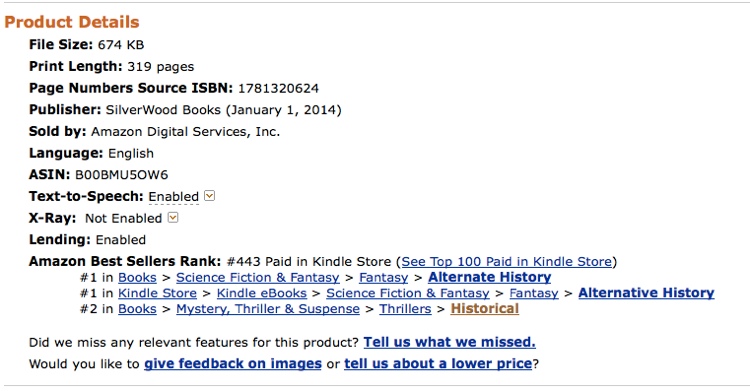
So I did this…

Alison Morton is the author of Roma Nova thrillers, INCEPTIO, and PERFIDITAS. Third in series, SUCCESSIO, is out early summer 2014.
If you enjoyed this post, do share it with your friends!Like this:Like Loading...
|
Subscribe to Blog via Email
Join 50 other subscribers.
Categories
Archive
|
 Basically, alternate history is a type of speculative fiction where stories are set in a world where historical events have unfolded differently from the way they did in the real world. The event that changed history (point of divergence or PoD) must be in the past from when the story is set and have affected the present in such a way that it can part-resemble our timeline or be very different. Sometimes there are actual historical characters, sometimes entirely fictional ones or a mixture of both.
Basically, alternate history is a type of speculative fiction where stories are set in a world where historical events have unfolded differently from the way they did in the real world. The event that changed history (point of divergence or PoD) must be in the past from when the story is set and have affected the present in such a way that it can part-resemble our timeline or be very different. Sometimes there are actual historical characters, sometimes entirely fictional ones or a mixture of both. Although there’s a lot of it about and modern favourites of mine include Robert Harris’s Fatherland, Keith Roberts’ Pavane and C J Sansom’s Dominion, it’s nothing new. Roman historian Livy suggests that the Romans would have beaten Alexander the Great if he had lived longer and had turned west to attack the Romans (Book IX, sections 17-19 Ab urbe condita libri (The History of Rome), Titus Livius).
Although there’s a lot of it about and modern favourites of mine include Robert Harris’s Fatherland, Keith Roberts’ Pavane and C J Sansom’s Dominion, it’s nothing new. Roman historian Livy suggests that the Romans would have beaten Alexander the Great if he had lived longer and had turned west to attack the Romans (Book IX, sections 17-19 Ab urbe condita libri (The History of Rome), Titus Livius). Like science fiction, alternate history varies in ‘hardness’ with readers and fans grading it by how plausible the alternation is measured against historical reality. At the ‘hard’ end are well-researched pieces that take into account historical sources and trends, logical changes due, for instance, to the butterfly effect, and try to relate events that flow logically from the point of divergence. At the ‘soft’ end are works of pure fantasy and ‘Rule of Cool’ (the level of ‘awesomeness’), generally a result of alien space bats (more classically, the dei ex machina).
Like science fiction, alternate history varies in ‘hardness’ with readers and fans grading it by how plausible the alternation is measured against historical reality. At the ‘hard’ end are well-researched pieces that take into account historical sources and trends, logical changes due, for instance, to the butterfly effect, and try to relate events that flow logically from the point of divergence. At the ‘soft’ end are works of pure fantasy and ‘Rule of Cool’ (the level of ‘awesomeness’), generally a result of alien space bats (more classically, the dei ex machina). Type X – Fantastical Alternate History: In contrast with Type IV, these works are deliberately designed as pure fantasy, typically following the Rule of Cool. Mad ideas prevail such as Nazis on the moon in the 2012 film Iron Sky.
Type X – Fantastical Alternate History: In contrast with Type IV, these works are deliberately designed as pure fantasy, typically following the Rule of Cool. Mad ideas prevail such as Nazis on the moon in the 2012 film Iron Sky.




















